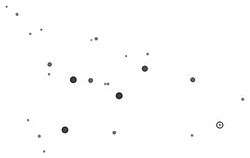Omega Cassiopeiae
Omega Cassiopeiae (ω Cassiopeiae) is a binary star[2] system in the northern constellation of Cassiopeia. It has a combined apparent visual magnitude of +4.99,[2] which means it is a faint star but visible to the naked eye. Based upon an annual parallax shift of 4.65 mas as seen from Earth,[1] this system is located roughly 700 light years from the Sun. At that distance, the visual magnitude is diminished by an extinction of 0.16 due to interstellar dust.[6]
| Observation data Epoch J2000.0 Equinox J2000.0 (ICRS) | |
|---|---|
| Constellation | Cassiopeia |
| Right ascension | 01h 56m 00.02784s[1] |
| Declination | +68° 41′ 06.8662″[1] |
| Apparent magnitude (V) | +4.99[2] |
| Characteristics | |
| Spectral type | B8 III[3] |
| U−B color index | −0.41[4] |
| B−V color index | −0.09[4] |
| Astrometry | |
| Radial velocity (Rv) | −24.8±4.2[5] km/s |
| Proper motion (μ) | RA: +14.96±0.17[1] mas/yr Dec.: −10.11±0.18[1] mas/yr |
| Parallax (π) | 4.65 ± 0.24[1] mas |
| Distance | 700 ± 40 ly (220 ± 10 pc) |
| Absolute magnitude (MV) | +0.09[6] |
| Orbit[7] | |
| Period (P) | 69.92 d |
| Eccentricity (e) | 0.30 |
| Periastron epoch (T) | 2420426.02 JD |
| Argument of periastron (ω) (secondary) | 50° |
| Semi-amplitude (K1) (primary) | 29.6 km/s |
| Details | |
| ω Cas A | |
| Mass | 4.7[8] M☉ |
| Luminosity | 488[9] L☉ |
| Surface gravity (log g) | 3.523±0.016[8] cgs |
| Temperature | 12,737±100[8] K |
| Rotational velocity (v sin i) | 33±15[8] km/s |
| Age | 232[6] Myr |
| Other designations | |
| Database references | |
| SIMBAD | data |
This is a single-lined spectroscopic binary star system with an orbital period of 69.92 days and an eccentricity of 0.30. The visible component has the spectrum of an evolved, B-type giant star with a stellar classification of B8 III.[3] It is a helium-weak star, a type of chemically peculiar star that displays abnormally weak absorption lines of helium for a star of its temperature.[11] Omega Cassiopeiae has an estimated 4.7[8] times the mass of the Sun and is radiating 488[9] times the Sun's luminosity from its photosphere at an effective temperature of around 12,737 K.[8]
References
- van Leeuwen, F. (2007), "Validation of the new Hipparcos reduction", Astronomy and Astrophysics, 474 (2): 653–664, arXiv:0708.1752, Bibcode:2007A&A...474..653V, doi:10.1051/0004-6361:20078357.
- Eggleton, P. P.; Tokovinin, A. A. (September 2008), "A catalogue of multiplicity among bright stellar systems", Monthly Notices of the Royal Astronomical Society, 389 (2): 869–879, arXiv:0806.2878, Bibcode:2008MNRAS.389..869E, doi:10.1111/j.1365-2966.2008.13596.x.
- Molnar, Michael R. (July 1972), "The Helium-Weak Stars", Astrophysical Journal, 175: 453, Bibcode:1972ApJ...175..453M, doi:10.1086/151570.
- Crawford, D. L. (February 1963), "U, b, v, and Hβ Photometry for the Bright B8- and B9-TYPE Stars", Astrophysical Journal, 137: 530, Bibcode:1963ApJ...137..530C, doi:10.1086/147526.
- de Bruijne, J. H. J.; Eilers, A.-C. (October 2012), "Radial velocities for the HIPPARCOS-Gaia Hundred-Thousand-Proper-Motion project", Astronomy & Astrophysics, 546: 14, arXiv:1208.3048, Bibcode:2012A&A...546A..61D, doi:10.1051/0004-6361/201219219, A61.
- Gontcharov, G. A. (November 2012), "Spatial distribution and kinematics of OB stars", Astronomy Letters, 38 (11): 694–706, arXiv:1606.09028, Bibcode:2012AstL...38..694G, doi:10.1134/S1063773712110035.
- Pourbaix, D.; et al. (2004), "SB9: The Ninth Catalogue of Spectroscopic Binary Orbits", Astronomy & Astrophysics, 424: 727–732, arXiv:astro-ph/0406573, Bibcode:2004A&A...424..727P, doi:10.1051/0004-6361:20041213.
- Huang, Wenjin; et al. (October 2010), "A Stellar Rotation Census of B Stars: From ZAMS to TAMS", The Astrophysical Journal, 722 (1): 605–619, arXiv:1008.1761, Bibcode:2010ApJ...722..605H, doi:10.1088/0004-637X/722/1/605.
- McDonald, I.; et al. (2012), "Fundamental Parameters and Infrared Excesses of Hipparcos Stars", Monthly Notices of the Royal Astronomical Society, 427 (1): 343–57, arXiv:1208.2037, Bibcode:2012MNRAS.427..343M, doi:10.1111/j.1365-2966.2012.21873.x.
- "ome Cas". SIMBAD. Centre de données astronomiques de Strasbourg. Retrieved 2017-08-29.
- Renson, P.; Manfroid, J. (May 2009), "Catalogue of Ap, HgMn and Am stars" (PDF), Astronomy and Astrophysics, 498 (3): 961–966, Bibcode:2009A&A...498..961R, doi:10.1051/0004-6361/200810788.
